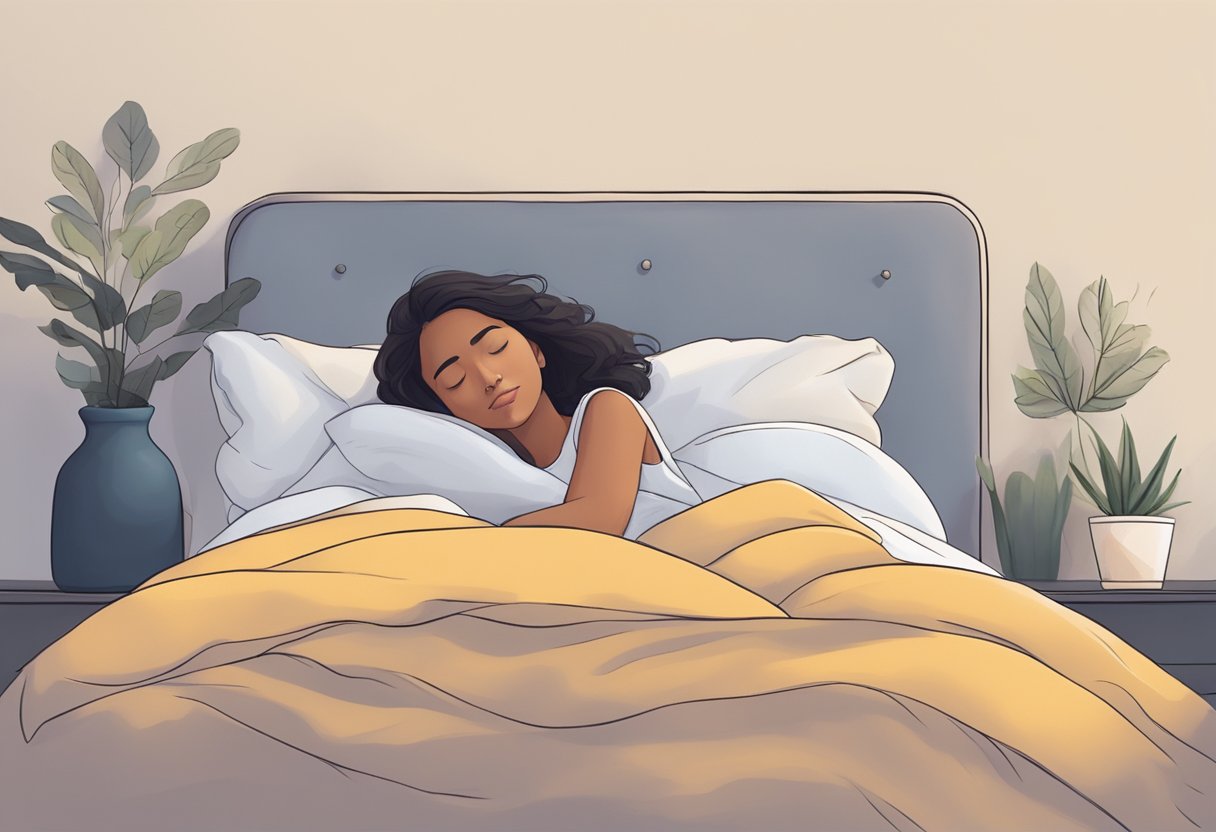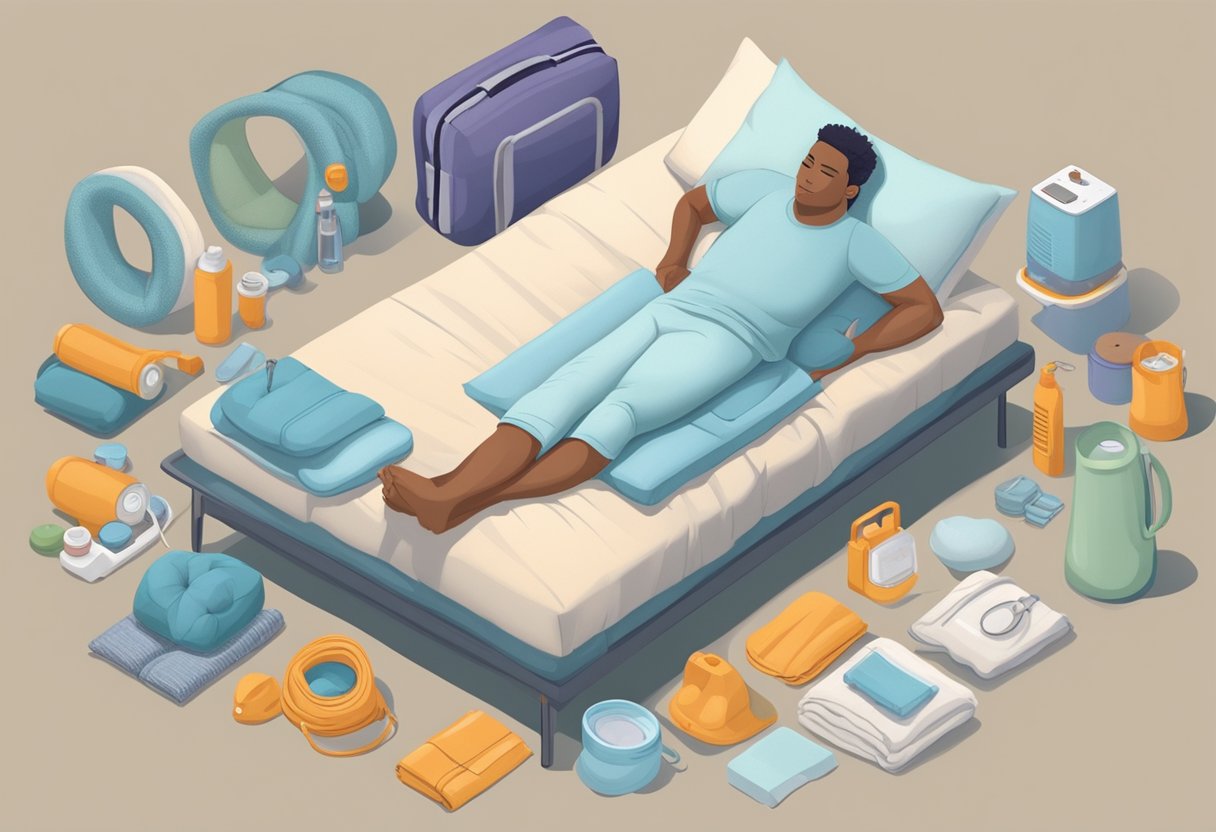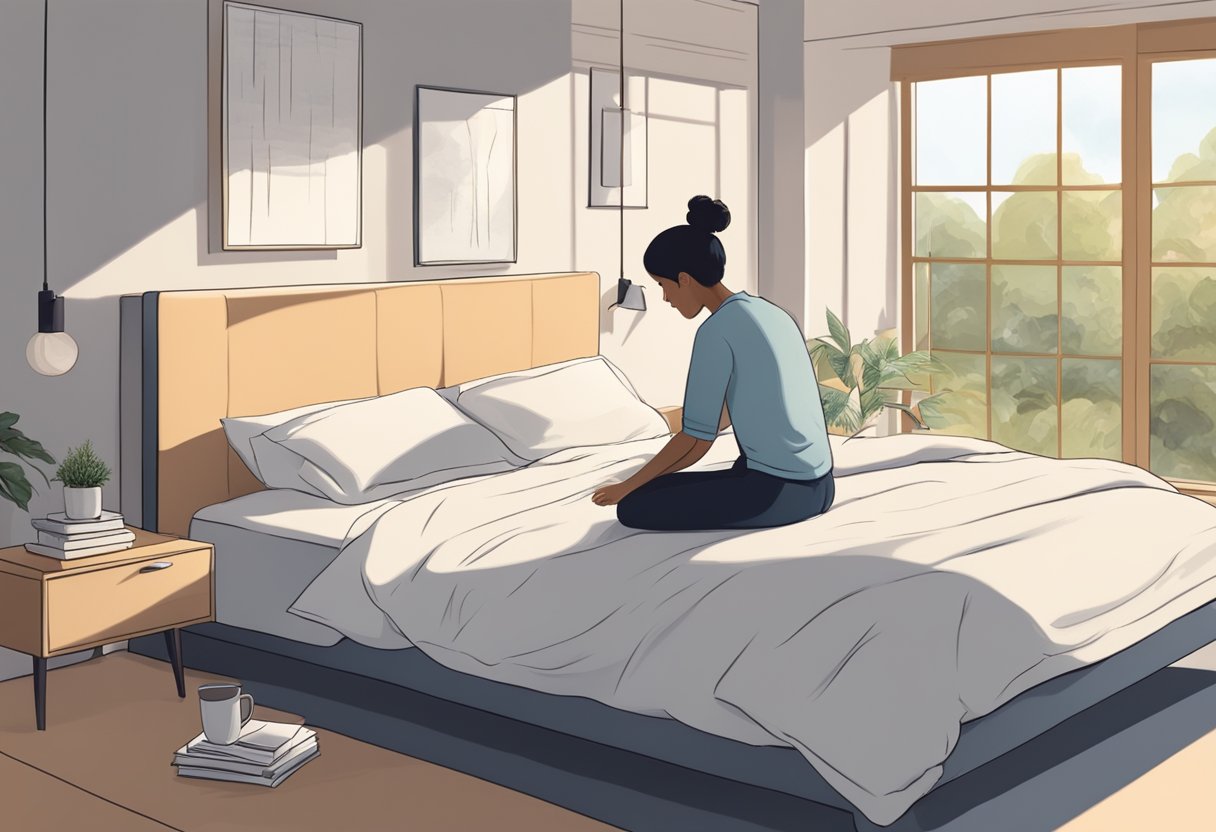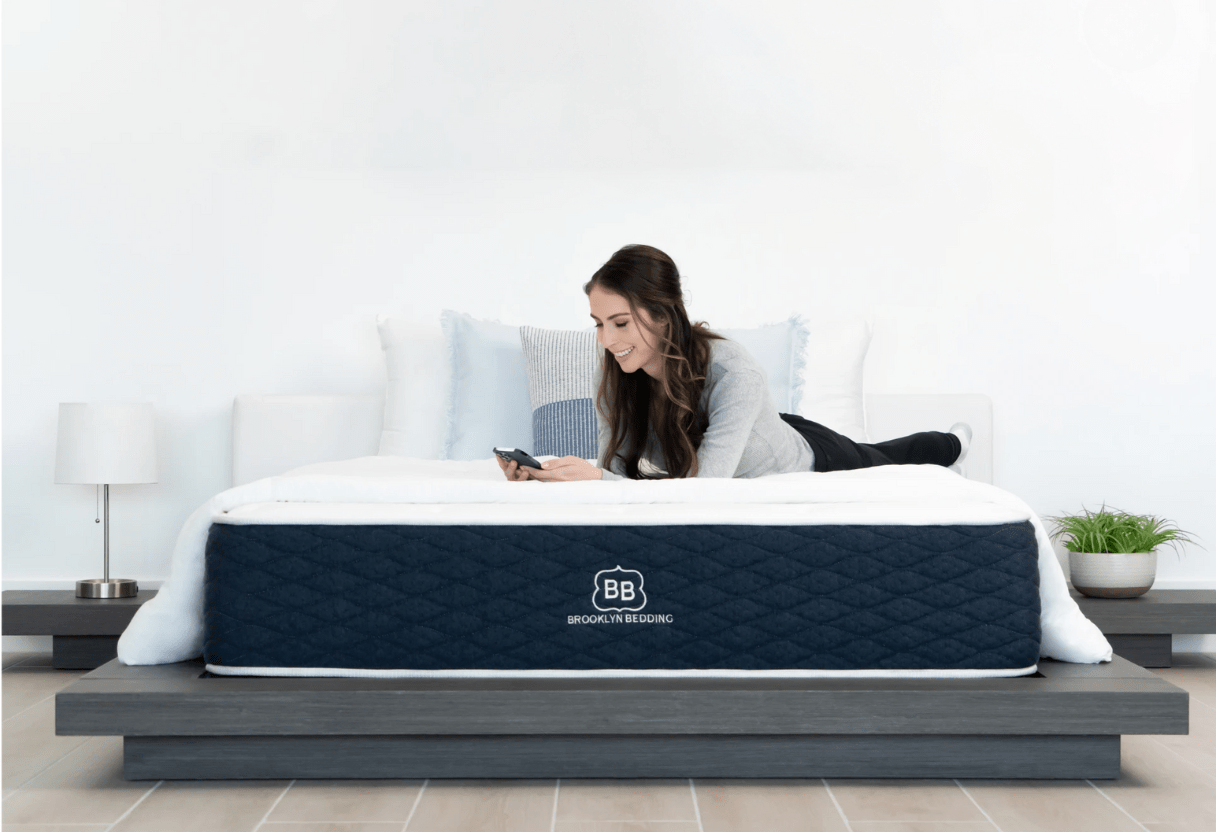Finding a comfortable sleep position is difficult for many who suffer from lower back pain. The best way to sleep with lower back pain is to lie on your back with a pillow under your knees, since this supports the spine’s natural curve.
An ideal sleep environment is also important in reducing pain. Mattress quality, room temperature, and reliable sleep tools all work together to enhance comfort and maintain spinal alignment throughout the night.
Using the right techniques and choosing effective tools allows those with lower back pain to achieve deeper rest and lasting relief. Even minor adjustments to sleep habits can lead to meaningful improvements in health and well-being.
Key Takeaways
- The right sleep position eases lower back pain.
- A supportive mattress and environment contribute to comfort.
- Bedtime routines encourage better sleep quality.
- The right mattress supports your spine and helps reduce pain during sleep, especially when paired with an optimal sleeping position.


Lower back pain is a common issue that affects sleep quality. It often results from muscle strain, poor posture, or underlying medical conditions. Understanding the root causes helps in identifying effective solutions.
Many people feel discomfort while sleeping, which may come from their mattress or sleeping position. A supportive bed is important in reducing lower back pain.
Common Causes of Lower Back Pain:
- Muscle strain
- Slipped discs
- Arthritis
When choosing a sleeping position for lower back pain, lying on the back with a pillow under the knees is better. This posture maintains the spine’s natural curve.
Some individuals find relief by sleeping on their side with their knees bent. This position reduces pressure on the spine and creates more space in the joints.
Aside from sleep posture, the best sitting position for lower back pain is also important. Practicing proper posture while sitting helps prevent strain on the lower back. Sitting in a chair with lower back support and keeping feet flat on the ground is better.

Choosing the right sleep position is essential for those battling lower back pain. The way a person sleeps can significantly impact spinal alignment and overall comfort during the night. Proper positioning can help reduce pain and promote better rest.
Evaluating Your Current Sleep Position
To understand the impact of sleep positions on lower back pain, begin by evaluating your current setup. Many people unknowingly adopt positions that strain the spine. Sleeping on the stomach or at awkward angles often causes discomfort.
Try keeping a sleep diary. Record the amount of pain felt upon waking and note the sleep positions used each night. Spotting patterns may reveal habits that worsen pain. Aim for a posture that preserves the spine’s natural curve.
Specific Sleeping Positions for Lower Back Pain
Some positions provide more relief than others for lower back pain.
- Back sleeping: Lying on your back with a pillow placed under the knees supports the lower back and keeps the spine in a neutral position.
- Side sleeping: Curling into a loose fetal position with knees pulled toward the chest may ease tension. This posture creates space between the vertebrae, which relieves spinal pressure.
- Reclined Position: Sleeping in a reclined setup is great for some people. An adjustable bed can help achieve this position and improve comfort overnight.
The Role of Pillows
Pillows also affect sleep quality and back support. Choosing the right one helps ease lower back pain.
Back sleepers benefit from placing a pillow under the knees to support spinal alignment. Side sleepers should use a firm pillow between the knees to keep the hips level.
Pillows and mattresses must suit the body’s shape and preferred sleep style to improve comfort and support better sleep. Good support at night sets the foundation for better overall health.

Creating a comfortable sleep environment is essential in reducing lower back pain. Two essential factors to consider are choosing the right mattress and using proper pillow placement techniques.
Choosing the Right Mattress
The mattress is important in supporting the spine. It must be firm enough to maintain spinal alignment while offering enough cushioning for comfort. A medium-firm mattress often suits individuals with lower back pain.
Key characteristics to consider:
- Support: Choose a mattress that maintains the spine’s natural curves.
- Material: Memory foam contours to the body, whereas latex provides more bounce and support.
Testing a mattress for several nights before making a purchase helps identify the one that best supports comfort and alignment.
Pillow Placement Techniques
Strategic pillow use can greatly affect comfort and pressure relief. Consider these placement methods:
- Under the knees: Back sleepers may benefit from placing a pillow under the knees to help preserve the spine’s natural curve.
- Between the knees: Side sleepers can reduce lower back strain by placing a pillow between the knees, keeping the hips properly aligned.
- Under the lower back: Some individuals find relief by positioning a small pillow under the lower back to enhance support.
Each of these techniques supports spinal alignment and helps reduce discomfort throughout the night.

Using the right sleeping aids and tools can significantly improve comfort and reduce pain for individuals with lower back issues. Proper support helps maintain spine alignment for a better night’s rest.
Supportive Bedding Accessories
Choosing the right bedding accessories is crucial for anyone experiencing lower back pain. Mattresses that provide good support help align the spine effectively.
- Medium-firm options are often recommended, as they balance support and comfort.
- Pillows are also important. Placing a pillow between the knees while sleeping on the side helps maintain proper alignment.
Lumbar support pillows offer additional stability and comfort. They reduce strain on the lower back and encourage a neutral spine position during sleep, which is vital for reducing pain.
Assistive Devices for Back Pain
Several assistive devices enhance sleep quality for those with lower back pain. Adjustable beds allow users to elevate their head or foot, which can reduce pressure on the spine
- Wedge pillows also serve this purpose by supporting the back and keeping the spine aligned while sleeping.
- Lumbar support cushions help improve posture, especially for back sleepers.
Using these devices not only adds comfort but also promotes a healthier sleeping position. Over time, they can noticeably reduce pain, making them valuable tools for better sleep.

Preparing the body for sleep is essential, particularly for those dealing with lower back pain. Specific stretching routines and relaxation techniques can promote comfort and improve sleep quality.
Stretching Routines
Gentle stretching before bed can alleviate tightness and improve flexibility. Effective stretches include:
- Knees-to-Chest Stretch: Lie on your back, pull one knee toward your chest, hold for 20 seconds, then switch legs.
- Cat-Cow Stretch: Start on hands and knees, arch your back upward, then lower it while lifting your head. Repeat several times.
- Child’s Pose: Kneel, sit back on your heels, and stretch your arms forward on the ground. Hold this position for 30 seconds.
These stretches not only relieve tension but also help with finding a comfortable position for lower back pain. Regular practice may reduce discomfort during the night.
Relaxation Techniques
Incorporating relaxation techniques can further prepare the body for sleep. Here are some helpful methods:
- Deep Breathing: Inhale deeply through the nose, hold for a moment, then exhale slowly. Repeat for five minutes to calm the mind.
- Progressive Muscle Relaxation: Tense and relax each muscle group, starting from the toes and moving upward. This promotes overall relaxation.
- Gentle Yoga: Performing light yoga poses can ease muscle tension and improve blood flow, making it easier to find the right position for restful sleep.
Practicing these techniques can effectively address how to lay down with lower back pain by promoting a restful state for both body and mind.

Managing lower back pain involves more than just the right sleeping position. Body weight, nutrition, and stress levels also affect spinal health. Making lifestyle changes can provide comfort and support for better sleep.
Managing Body Weight for Back Health
Carrying excess weight can strain the back. Maintaining a healthy weight through a balanced diet and regular exercise reduces pressure on the spine and lowers the risk of back pain.
Tips for Weight Management:
- Regular Exercise: Aim for at least 150 minutes of moderate activity each week.
- Portion Control: Be mindful of portion sizes to avoid overeating.
- Track Progress: Use a journal or app to monitor food intake and activity levels.
By managing body weight, individuals may experience reduced back pain, making sleep more restful.
Nutrition and Hydration
Good nutrition fuels the body and supports back health. A diet rich in vitamins and minerals strengthens bones and muscles, while staying hydrated is crucial for overall health.
Key Nutrients for Back Health:
- Calcium: Found in dairy products and leafy greens, calcium helps maintain bone strength.
- Vitamin D: This nutrient aids in calcium absorption. Sources include sunlight, fish, and fortified foods.
- Omega-3 Fatty Acids: Found in fish like salmon, these can reduce inflammation in the body.
Drinking enough water also keeps muscles and joints lubricated, which can alleviate some discomfort.
Stress Management
Stress contributes to muscle tension, which can lead to increased back pain. Practicing stress management techniques can help reduce tension in the body and improve sleep quality.
Effective Stress-Relief Techniques:
- Mindfulness Meditation: Spend a few minutes daily focusing on breathing to calm the mind and body.
- Yoga: Promotes flexibility and relaxation. Simple stretches can ease tension in the back.
- Adequate Sleep: Establish a regular sleep routine to ensure the body gets the rest it needs.
By reducing stress levels, individuals may experience less back pain, leading to better sleep, especially for those with lower back issues.
Persistent lower back pain can be troubling, and it is essential to recognize when it signals a need for medical attention. Identifying red flags and seeking professional advice can help prevent further complications.
Identifying Red Flags
Certain symptoms indicate that immediate medical care may be necessary. If lower back pain is accompanied by numbness or tingling in the legs or feet, it could suggest nerve involvement. Pain following a traumatic injury, such as a fall or accident, warrants prompt evaluation.
Additionally, if the pain radiates down one leg, it might signal sciatica. Unexplained weight loss, fever, or bowel and bladder issues also require attention. If the pain lasts longer than a week or worsens despite home care efforts, consulting a medical professional becomes crucial. Ignoring these signs could lead to more serious problems.
Seeking Professional Medical Advice
Anyone experiencing persistent lower back pain should consult a doctor. A doctor can perform a thorough examination to determine the root cause of the pain. This may involve physical exams, imaging tests, or blood work.
Doctors may inquire about the patient’s sleeping positions and daily habits, as these can influence back health. Treatment options range from physical therapy to medications or injections. In some cases, surgery may be necessary. Patients should not hesitate to seek help to find effective relief and learn how to sleep better to alleviate lower back pain.

Choosing the right mattress is crucial for anyone with lower back pain. A good mattress can provide support and comfort, potentially easing pain during sleep.
Types of Mattresses Recommended:
- Medium-Firm Mattresses: These offer a balance of support and comfort, making them ideal for back pain relief. They help maintain spinal alignment while offering pressure relief.
- Firm Mattresses: These suit those who prefer extra support. They help keep the body in a neutral position, which may prevent discomfort.
- Soft Mattresses: Though less commonly recommended, some people with specific needs find relief with softer options as they contour to the body’s curves.
Key Features to Consider:
- Support: The mattress must support the natural curves of the spine.
- Pressure Relief: It should reduce pressure points to prevent discomfort during the night.
- Spinal Alignment: A good mattress keeps the spine aligned, which is essential for reducing pain.
The Brooklyn Bedding Signature Hybrid is best for lower back pain. It’s available in soft, medium, and firm options to tailor an individual’s preference. The medium-firmness version is recommended for those with lower back pain. It combines a supportive coil system with pressure-relieving foam. Its hybrid construction also supports spinal alignment and contours to reduce pressure points for comfort throughout the night.
For more detailed information about mattress options for comfort and support, check this comprehensive guide.
Frequently Asked Questions
Many people look for ways to sleep better while managing lower back pain. The following questions address common concerns about sleep positions and adjustments that may help ease discomfort.







